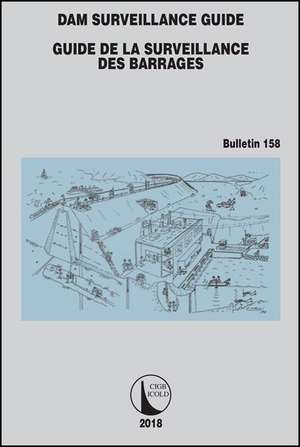Dam Surveillance Guide: ICOLD Bulletins Series
Editat de CIGB ICOLDen Limba Engleză Paperback – 10 aug 2018
The objective of dam surveillance is to make a precise and timely diagnosis of the behavior of dams, in order to prevent undesirable consequences. Both the monitoring system and surveillance program has to be designed and should be able to detect any abnormal behaviour. ‘Dam surveillance’ (ICOLD Bulletin 158), emphasizes the following aspects:
• Routine visual inspection
• Special inspection
• Checking and testing of Hydro-electromechanical equipment
• Monitoring parameters and devices
• Automation
• Maintenance of ageing monitoring systems
• Re-instrumentation of existing dams
• Recent developments
• Data management
• Dam documentation management
• Assessment of dam condition and behaviour
• Assessment of routine dam safety monitoring programme
• Prioritization of maintenance, remedial and upgrading works.
Preț: 700.75 lei
Preț vechi: 854.57 lei
-18% Nou
Puncte Express: 1051
Preț estimativ în valută:
134.08€ • 140.37$ • 110.95£
134.08€ • 140.37$ • 110.95£
Carte tipărită la comandă
Livrare economică 05-19 aprilie
Preluare comenzi: 021 569.72.76
Specificații
ISBN-13: 9781138490208
ISBN-10: 1138490202
Pagini: 222
Dimensiuni: 156 x 234 x 12 mm
Greutate: 0.45 kg
Ediția:1
Editura: CRC Press
Colecția CRC Press
Seria ICOLD Bulletins Series
ISBN-10: 1138490202
Pagini: 222
Dimensiuni: 156 x 234 x 12 mm
Greutate: 0.45 kg
Ediția:1
Editura: CRC Press
Colecția CRC Press
Seria ICOLD Bulletins Series
Public țintă
Postgraduate and ProfessionalCuprins
1 Introduction
2 Visual inspections and special/ad hoc inspections
3 Checking and testing hydro-mechanical equipment
4 Monitoring parameters and devices
5 Automation
6 Maintenance and ageing of monitoring systems
7 Re-instrumentation of existing dams
8 Recent instrumentation developments and applications
9 Data management
10 Dam documentation management
11 Assessment of condition and behavior of dams
12 Assessment of dam safety monitoring programme
13 Prioritisation of maintenance, remedial and upgrading monitoring systems
14 Concluding remarks
2 Visual inspections and special/ad hoc inspections
3 Checking and testing hydro-mechanical equipment
4 Monitoring parameters and devices
5 Automation
6 Maintenance and ageing of monitoring systems
7 Re-instrumentation of existing dams
8 Recent instrumentation developments and applications
9 Data management
10 Dam documentation management
11 Assessment of condition and behavior of dams
12 Assessment of dam safety monitoring programme
13 Prioritisation of maintenance, remedial and upgrading monitoring systems
14 Concluding remarks
Notă biografică
the Commission Internationale des Grands Barrages (CIGB) / International Commission on Large Dams (ICOLD) is a non-governmental International Organization which provides a forum for the exchange of knowledge and experience in dam engineering.
The Organization leads the profession in ensuring that dams are built safely, efficiently, economically, and without detrimental effects on the environment. Its original aim was to encourage advances in the planning, design, construction, operation, and maintenance of large dams and their associated civil works, by collecting and disseminating relevant information and by studying related technical questions.
Since the late sixties, focus was put on subjects of current concern such as dam safety, monitoring of performance, reanalysis of older dams and spillways, effects of ageing and environmental impact. More recently, new subjects include cost studies at the planning and construction stages, harnessing international rivers, information for the public at large, and financing.
The Organization leads the profession in ensuring that dams are built safely, efficiently, economically, and without detrimental effects on the environment. Its original aim was to encourage advances in the planning, design, construction, operation, and maintenance of large dams and their associated civil works, by collecting and disseminating relevant information and by studying related technical questions.
Since the late sixties, focus was put on subjects of current concern such as dam safety, monitoring of performance, reanalysis of older dams and spillways, effects of ageing and environmental impact. More recently, new subjects include cost studies at the planning and construction stages, harnessing international rivers, information for the public at large, and financing.
Descriere
Dams are part of human achievements that induce great benefits for society but also bear a potential risk to people, property and the natural environment. The risk of a dam rupture is extremely low and difficult to quantify accurately. The objective of dam surveillance is to make a precise and timely diagnosis of the behavior of dams, in order to prevent undesirable consequences. Both the monitoring system and surveillance program has to be designed and should be able to detect any abnormal behaviour. The aim of ‘Dam surveillance’ (ICOLD Bulletin 158) is to help reduce these risks by early detection of an undesirable event.



























